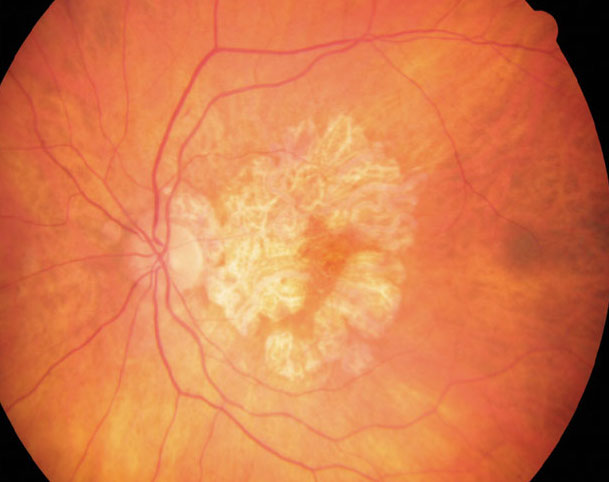 |
Future therapies targeting the gene ARMS2/HTRA1 may be effective in treating AMD disease by decreasing GA development and slowing its expansion. Click image to enlarge. |
A recent analysis of the mechanisms that give rise to geographic atrophy (GA) in AMD patients, published in Ophthalmology Science, seeks to untangle the interplay of environmental and genetic characteristics in its pathophysiology. The author, from the National Eye Institute’s Division of Epidemiology and Clinical Applications, offered an appraisal of the literature to date. His biggest takeaway was an awareness of the somewhat overlapping but ultimately divergent processes that govern AMD’s progression to GA and the lesions’ subsequent expansion over time.
The gene ARMS2/HTRA1 was a shared factor, with risk variants that increased likelihood of progression to GA and GA expansion rate. The author thought they operate by the same mechanism at both stages. The gene CFH/CFHR, conversely, had risk and protective variants that altered risk of GA but not its expansion rate. One risk variant at C3 increased risk for GA but was also associated with slower GA expansion.
As for environmental factors, older age was found to be associated with increased risk of GA, but not faster GA expansion. Cigarette smoking was a factor associated with both stages, as was a Mediterranean diet, but associated instead with decreased progression. Still, the largest contributions of food components appeared different between both stages. Increased progression at both stages was also linked to phenotypic features of reticular pseudodrusen and hyperreflective foci.
The only real overlap genetically was with ARMS2/HTRA1, with the rest listed showing independent or converse effects of the two stages. The author of the paper used these observations to suggest that “the biologic mechanisms differ at least partially between the two disease stages, which has implications for therapeutic approaches and suggests that treatment aimed at the underlying disease processes may need to be tailored by stage.”
The author then addresses the potential treatment options that exist for AMD patients with this form of the disease. While oral AREDS supplements are used at more severe stages to decrease risk of progression to advanced wet AMD, this treatment appears to have little effect on decreasing progression to GA and a possible but uncertain effect for slowing GA expansion.
Another potential treatment option is local complement inhibition. Studies targeting C3 and C5 levels have seen resultant slowed decrease in GA expansion. One study using a C3 inhibitor found monthly treatment to be nominally significant in decreasing progression from incomplete to complete retinal pigment epithelium and outer retinal atrophy, characteristics of progression to GA. As such, local complement inhibition may be effective at both stages of disease, since it seems to operate in the same direction.
The author concluded with a suggestion on the best current treatment that these AMD patients may receive. “Importantly, alongside pharmacological interventions, these data indicate that lifestyle modification may be effective at all stages. Smoking cessation may be helpful at any stage. Similarly, the Mediterranean diet is strongly associated with decreased progression to intermediate AMD, decreased progression to GA, and slower GA expansion.” AREDS supplements also remain appropriate, he suggested, alongside a healthy diet “since associations with decreased progression to late AMD appear additive, without redundancy or other interaction.”
Keenan TDL. Geographic atrophy in age-related macular degeneration: a tale of two stages. Ophthalmology Science. April 10, 2023. [Epub ahead of print]. |


